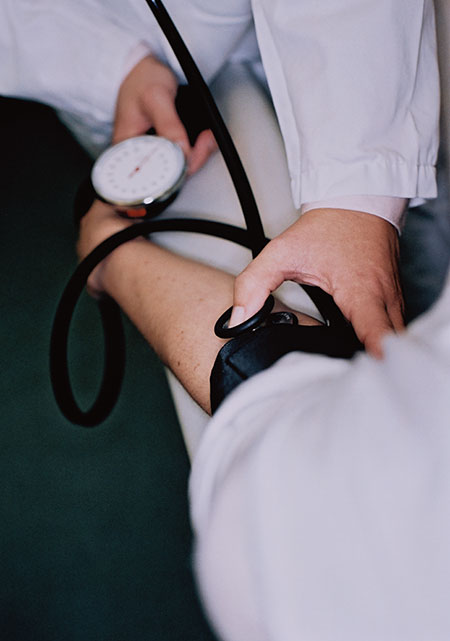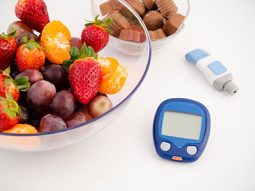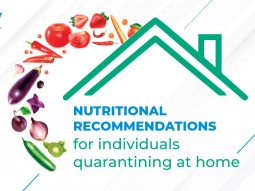Regular diabetes care can help you prevent heart disease, stroke, and eye, foot, or kidney problems. This guide describes basic care for people with diabetes.
Most of the day-to-day care of diabetes is up to you:
- You choose what, when, and how much to eat.
- You decide whether to be physically active.
- You take your medicines.
- You keep track of your blood glucose (sugar) levels.
Your health care team helps by teaching you about diabetes care and checking your A1C (average blood glucose), blood pressure, cholesterol, and other measures.
What should happen during visits to my health care provider?
Use the following list to make sure you and your health care team are up-to-date on what you need for good diabetes care.
Check at every office visit
- Blood pressure: If your blood pressure is not on target, meal planning, physical activity, and medicines can help.Work with your health care team to plan your strategy.
- Weight: Preventing weight gain or losing weight may be part of your diabetes care plan. If you need to lose weight, 4.- 7 kg loss can help you reach your blood pressure, blood glucose, and cholesterol goals. Work with your health care team to plan your goals.
- Smoking: If you smoke, ask your health care provider about a plan to help you quit.
- Feet: Ask your health care provider to check your feet. Report any changes in how your feet look or feel. Foot problems can be avoided if detected and treated early.

Check at least every 3 to 6 months
A1C: The A1C is the blood glucose check “with a memory.” It tells you your average glucose concentration for the past 2 to 3 months. Your blood glucose may also be reported as Random or Fasting Blood Glucose (FBG). These glucose levels report your glucose level in a given point in time. If your blood glucose is too high, you may need a change in your diabetes care plan. Talk with your health care team.

Check at least once a year
- Cholesterol: Your cholesterol numbers tell you the amount of fat in your blood. Some kinds, like HDL, help protect your heart. Others, like LDL, can clog your blood vessels and lead to heart disease. Triglycerides, another kind of blood fat, raise your risk for a heart attack or a stroke. If your cholesterol levels are not on target, meal planning, physical activity, and medicines can help. Work with your health care team to plan your goals.
- Foot and eye exams: Once a year, your health care provider can check your feet more thoroughly for signs of nerve damage or other problems. An eye doctor should
- check your eyes for early warning signs of damage.
- Seasonal Flu shot: Ask for a flu shot every year to keep from getting sick.
Other things to do
- Pneumonia vaccine: Get the pneumonia vaccine at least once.
- Diabetes education and nutrition counselling: If you need a change in your diabetes management plan, ask your health care provider to refer you for diabetes education and nutrition counselling.
- Pregnancy: Talk to your health care provider if you plan to become pregnant. Work to get to a healthy weight before and during pregnancy.
- Tracking your targets
- The American Diabetes Association (ADA) suggests these targets for most people with diabetes. You may have different targets from your health care provider. You can record your targets and your results in the spaces provided here.
| What to Do | ADA Targets | My Targets | My Results Date__________ | My Results Date__________ |
| At Every Office Visit | ||||
| Review blood glucose numbers | ||||
| Fasting Blood Glucose | 0.65 – 1.06 g/L | |||
| Glucose (Blood) | 0.74 -1.06 g/L | |||
| Post Prandial Glucose – 2hr | Below 1.55 g/L | |||
| Check blood pressure | Below 140/90 mmHgBelow 130/80mmHg for certain individuals | |||
| Review meal plan | ||||
| Review activity level | ||||
| Check weight | ||||
| Discuss questions or concerns | ||||
| Check your feet | ||||
| At Least Every 3 Months | ||||
| A1C, also reported as A1C (IFCC) | Below 7% orbelow 53 mmol/mol | |||
| At Least Once a Year | ||||
| Physical exam | ||||
| LDL cholesterol | Optimal: <1.0 g/L; Borderline – High Risk: 1.0 – 1.9 g/L; High Risk > 1.9 g/L | |||
| HDL cholesterol | Males: Desirable: >0.56 g/L; Borderline: 0.35 – 0.56 g/L; High < 0.35 g/L | |||
| Females: Desirable: >0.65 g/L; Borderline: 0.45 – 0.65 g/L; High < 0.45 g/L | ||||
| Triglycerides | Desirable: <1.5 g/L; Borderline – High Risk: 1.5 – 5 g/L;Very High Risk > 5 g/L | |||
| Dilated eye exam | ||||
| Flu shot | ||||
| Thorough Foot Exam | ||||
| Once | ||||
| Pneumonia vaccine | ||||

 Vi
Vi 












